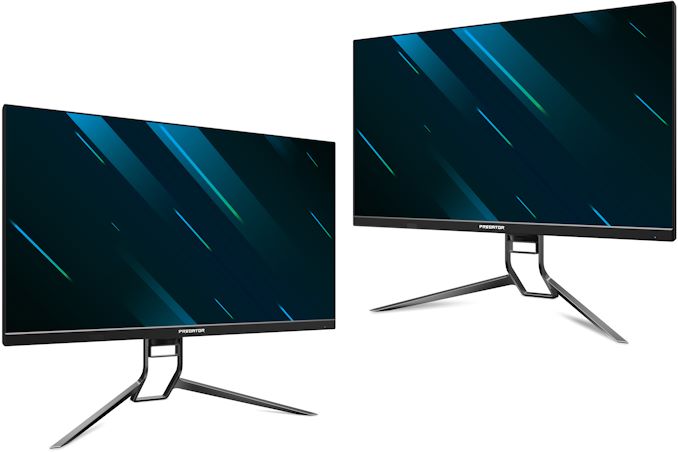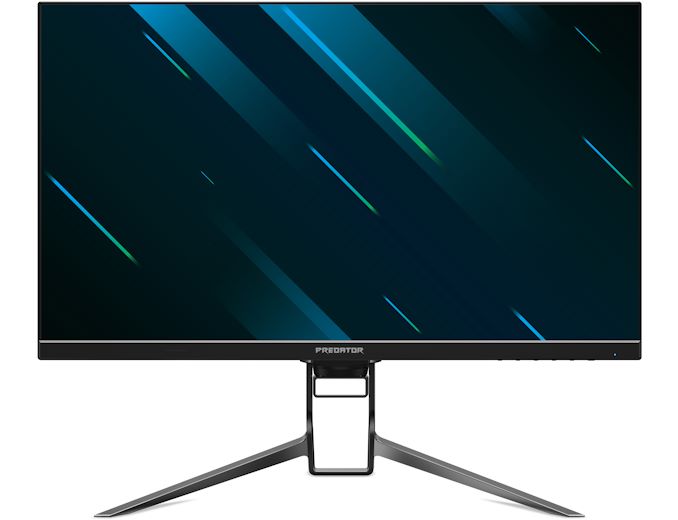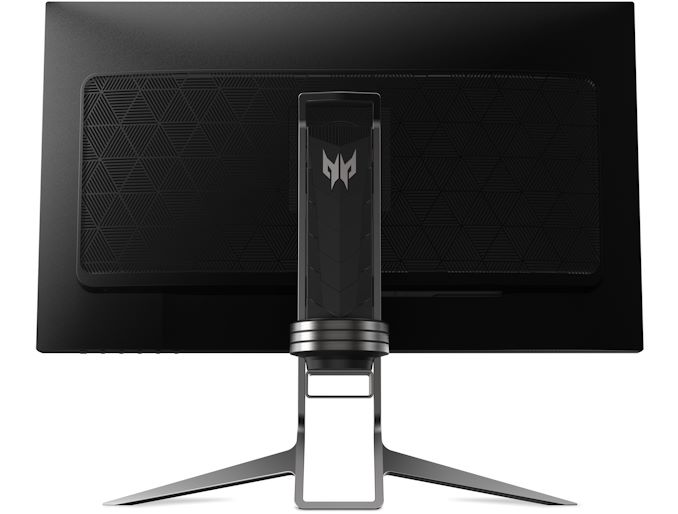CES 2020: Acer’s Predator X32 4Kp144 Monitor w/1152-Zone Mini LED FALD & G-Sync Ultimate
by Anton Shilov on January 6, 2020 1:30 PM EST
Acer and ASUS were the first and only companies to announce 27-inch NVIDIA G-Sync HDR 4Kp144 displays with a 384-Zone Mini LED-based Full Array Local Dimming (FALD) backlighting, and the DCI-P3 color space support three years ago. Time has come to up the ante and at CES 2020 Acer is announcing its Predator X32: a 32-inch G-Sync Ultimate 4Kp144 display that improves its predecessor in every possible way.
Acer’s Predator X32 is based on a 10-bit IPS panel with a 3840×2160 resolution that is equipped with a Mini LED-based backlighting. The updated Mini LED system offers 1,152 individually controlled local dimming zones, enabling a peak birghtness of 1400 nits in HDR mode as well as a very high contrast ratio. In fact, the combination of the higher peak brightness and the higher number of dimming zones, promises a solid improvement of HDR image quality when compared to the Predator X27.
The monitor can display 1.07 billion of colors and reproduce the sRGB, Adobe RGB, PCI-P3, and Rec. 2020 color spaces. Furthermore, the Predator X32 comes factory calibrated with a DeltaE<1 accuracy.
Apart from a high luminance, a high contrast ratio, and wide color spaces, one of the Predator X32's key selling points is support for a variable refresh rate of up to 144 Hz handled by NVIDIA’s G-Sync Ultimate processor. As with other G-Sync Ultimate monitors, enabling a 144 Hz refresh rate requires 4:2:2 chroma subsampling due to interface bandwidth constraints. Speaking of interfaces, it is necessary to note that the monitor has a DisplayPort 1.4 as well as three HDMI 2.0 connectors. In addition, the monitor has a quad-port USB 3.0 hub for various peripherals.
Acer intends to start selling its Predator X32 gaming monitor in EMEA and North American regions sometimes in the second quarter. Of course, pricing of an almost exclusive product will be high: €3,299 in Europe and $3,599 in the USA.
| Brief Specifications of the Predator X32 4Kp144 Display | |
| Predator X32 | |
| Panel | 32" IPS |
| Native Resolution | 3840 × 2160 |
| Maximum Refresh Rate | up to 144 Hz |
| Response Time | ? |
| Brightness | ? cd/m² (sustained) 1440 cd/m² (peak) |
| Contrast | high |
| Viewing Angles | 178°/178° horizontal/vertical |
| HDR | Yes |
| Backlighting | Mini-LED-based 1152-zone FALD |
| Pixel Pitch | 0.1845 mm² |
| Pixel Density | 138 ppi |
| Display Colors | 1.07 billion |
| Color Gamut Support | Adobe RGB DCI-P3 (?) Rec. 2020 sRGB |
| Aspect Ratio | 16:9 |
| Stand | Hight, Tilt, and Swivel adjustable |
| Inputs | 1 × DisplayPort 2 × HDMI 2.0 |
| USB Hub | 4-port USB 3.0 hubs |
| Audio | 2 × 4 W speakers audio jack |
| Launch Date | Q2 2020 |
Related Reading:
- Lenovo Unveils ThinkVision Creator Extreme P27: A Professional Monitor with Mini LED FALD
- ASUS ProArt PA32UCG: The Ultimate Mini LED 4K 120 Hz Monitor with HDR 1600
- ASUS Mini LED Professional Monitors Update: Available This Year
- Acer Joins Mini LED Monitor Club with Professional-Focused ConceptD CM7321K
- ASUS at CES 2019: ProArt PA32UCX 4K Monitor with 1000-Zone FALD Unveiled
- AUO’s Mini LED Monitors: 32-Inch 4Kp144, 65-Inch 4Kp144, VR, & Others
Source: Acer












14 Comments
View All Comments
TristanSDX - Monday, January 6, 2020 - link
No DSC and 4:2:2 ? Crapnevcairiel - Monday, January 6, 2020 - link
Rather get HDMI 2.1 or DP 2.0 to get by without needing any sort of compression, neither DSC nor chroma subsampling.I suppose they are trying to save money on the HDMI 2.1 module as no graphics cards support it yet. Guess 2020 is not my new monitor year quite yet (even if it wouldn't have been this one specifically, anyway).
lilkwarrior - Tuesday, January 7, 2020 - link
Turing supports HDMI 2.1 VRR so no excuse. And Nvidia will certainly support HDMI 2.1 with their upcoming GPUs. I dunno why AMD is releasing cards 2020 without it. Then again Navi has been pretty confusing in value proposition w/ a Navi 2 I guess to actually have a PC AMD card that's also next-gen ready (ray-tracing & so on).zodiacfml - Monday, January 6, 2020 - link
Ouch. I thought Acer has competitive prices.